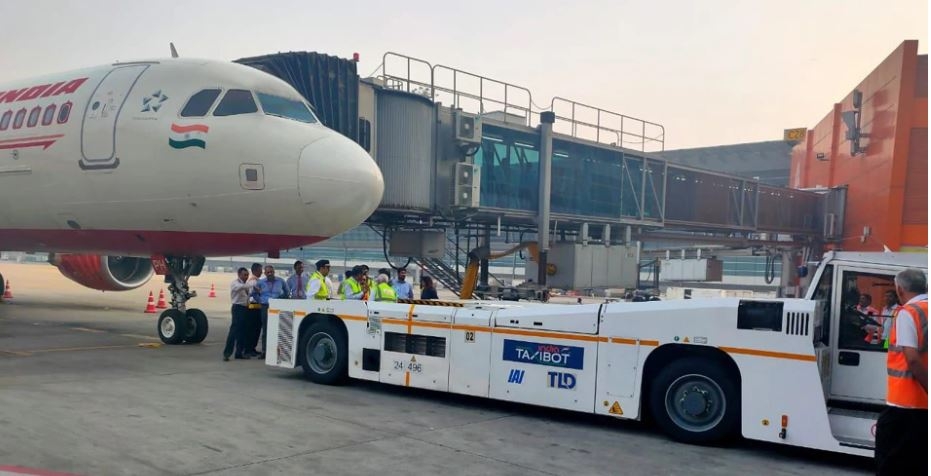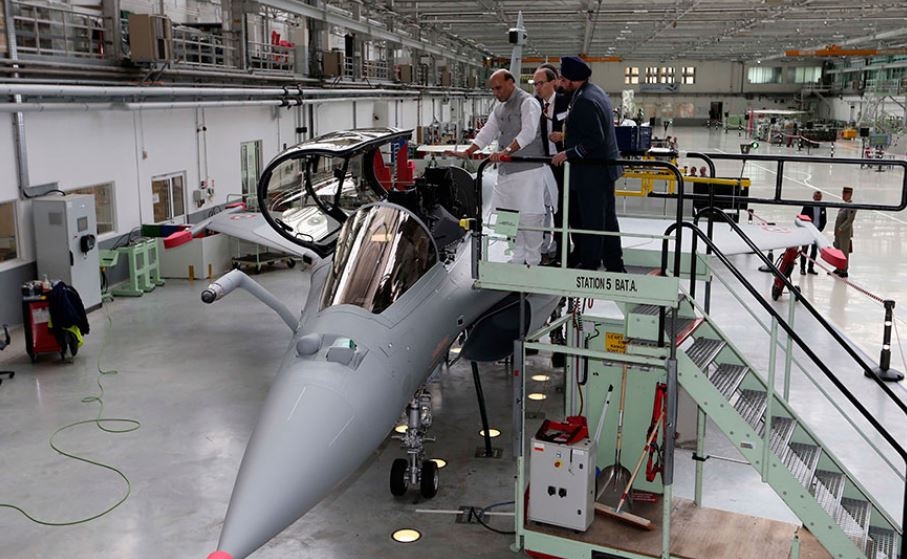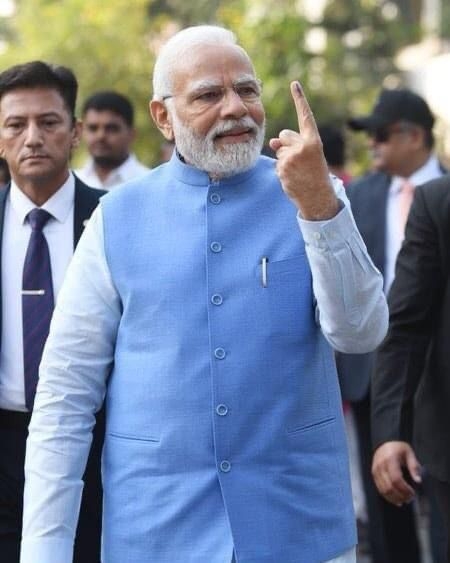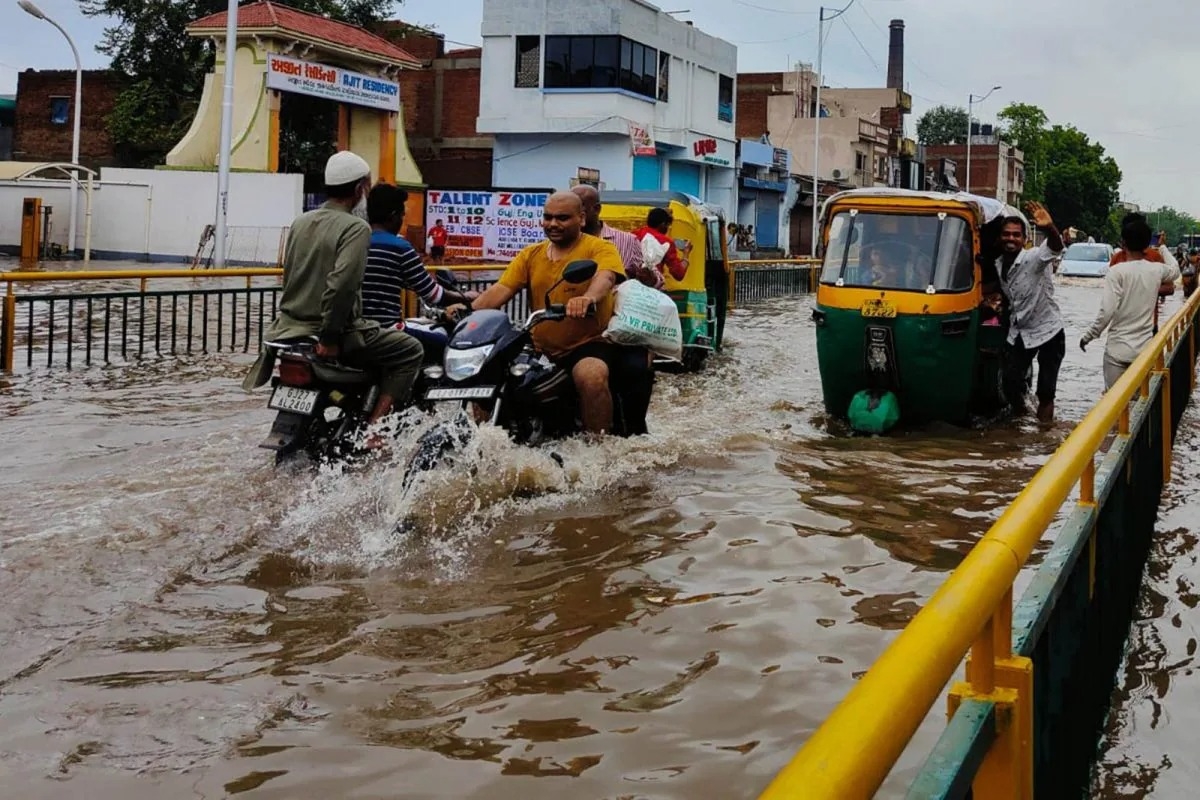By : Varsha Bhagat Ganguly
​​​​​​Title: Challenges of enormous electronic waste in India
As per an estimate, India generates 18-20 metric ton (MT) – 200 crores electronic waste (e-waste) every year. So if we divide this amount of e-waste with population of India, about 1.4 kg e-waste is existing per head in India! What do we do to manage such a huge challenge, which has potential of severe adverse effect on health of human as well as environment? What should the government be doing about managing e-waste?
Do you know how much electronic waste (e-waste) exist in India? What is the relevance of e-waste management in our lives?
We live in a digital age. Every electronic gadget provides us comfort and advancement, for example, mobile is used for communication. Through mobile we develop our business, socialisation – stay connected with family, relatives and friends, and many more purposes. Once mobile stops working or its upgraded version is available, we buy another and similarly every gadget is bought – television, refrigerator, computer or laptop and some such device. we do not bother much about the device that is not used anymore and turns into waste.
As per an estimate, India generates 18-20 metric ton (MT) electronic waste (e-waste) every year. One metric ton is equal to 1,000 kilograms. Thus, 20 MT becomes 200 crores. The extent of e-waste increases by a rate of 30% every year because, in a digital age, we need digital gadgets for every task. There would be 52 MT e-waste in India by the year 2023, which means if we do not start managing e-waste, every India citizen has about 4.0 kg of e-waste to deal with!
What do we do to manage such a huge challenge, which has potential of severe adverse effect on health of human as well as environment? What should the government be doing about managing e-waste? To know more about e-waste management, do read the next episode.
Title: E-waste classification
Electronic waste is – when any electronic device become dysfunctional – not repairable, not re-useable and not re-furbishable and it is obsolete. The Central Pollution Control Board (CPCB), India has listed 21 items, divided into mainly two types of electronic items and waste – consumer electronics and information technology (IT). Of this list, most of us use at least ten electronic gadgets – at home or at work place on every day basis. Internationally, six categories of e-waste are classified, as against two Indian classifications.
Let us start making a list of electronic and electrical items, most frequently seen and used. Many people would be able to list out at least 50 electronic items – at home and at work place. When any electronic item becomes obsolete, non-useable and non-repairable, also that the technology is obsolete, it become a ‘waste’. For example, valve based television or transistor is obsolete technology; telegram machine is also obsolete. The pen-drives and DVDs are used as data storage devices, old floppy disks are obsolete on the counts of hardware and software.
Largely there are two types of electronic items – (i) consumer electronics including large household appliance – television, refrigerator, bulbs / CFL and tube-lights, washing machine, music system, camera, mixer & grinder, air conditioner, CD & DVD player, etc. and (ii) IT related – mobile, computer, laptop, printer, scanner, tablet / iPad, and their accessories, such as adaptor, cables, headphones, etc. All of them are part of our daily life, and we all know that every device has specified life. After the device lives its life, it turns into ‘e-waste’.
Internationally, six categories of e-waste are classified; they are – large equipment (household appliances), small equipment (household appliances), temperature exchange equipment, small IT equipment, lamps, and screens and monitors. Two international classification are recognised – one made by UNU (United Nations University) and another by European Union, known as European List of Wastes (LoW).
Title: Low level of awareness about e-waste among citizens of India
How many of Indian citizens know about what e-waste is and whether it is hazardous and toxic? What is the role of awareness in dealing with problems of e-waste? What are the results of low level of awareness about extent and toxicity of e-waste, end-of-life solution, and safe disposal options – prevalence / dominance of informal sector for handling e-waste continues, therefore toxic effects of e-waste continue to harm environment and human health, especially of workers working in informal sector.
Today we will talk about role of ‘awareness’ and ‘informed consent’, which are believed to be the first steps for solving a problem. Every electronic item works with electro-magnetic field through metals, which affect our neurons, other organs like lungs and lever, and parts of body such as skin, eyes, etc. When disease like cancer is at epidemic level, we need to take protective measure against cancer. Similarly, if we understand hazards of e-waste – more e-waste, more hazard – then we try to either reduce e-waste or find a solution for its end-of-life or it’s recycling.
A study by Toxic Link of 2015 inform us that 50% respondents know about e-waste but cannot differentiate it from other type of wastes (such as paper, card board, etc.) and only one-fourth (28%) knew that e-waste is toxic. What did they do with e-waste – only 0.7% disposed e-waste to authorised recycler, 51% of the respondents disposed e-waste to kabadiwala, 36% resale or exchange electronic items, and 16% gave away to friends, relatives or maids.
What is the result of such low level of awareness about extent and toxicity of e-waste, end-of-life solution, and safe disposal options? 66% did not know that the government has come up with ‘E-waste (Handling & Management) Rules in 2011, which were revised in 2016.
Title: Why is it necessary to manage e-waste? (Hazardous impact of e-waste on human health)
For any waste to be handled, the framework of 3Rs – Reduce, Reuse and Recycle is used. In case of e-waste, LOHAS – Lifestyle of Health and Sustainability framework is also relevant. As part of sustainability – reduced impact on health, environment, and social extraction of reusable materials like metals, lifestyle and purchasing decisions, etc. are considered. Through economic model of ‘circular economy’, the concept promotes the consumers to be participants for making a difference in terms of social and environmental impact of the electronic products.
Every electronic product has possibility of hazardous impact on health and environment but it also offers economic opportunity by extracting and reusing different resources – metal, glass and plastic. As per one estimate, e-waste generated in 2016 had a recovery value of 55 billion euros (approx. 4,60,000 crore rupees) from 4770 crore MT e-waste. India has about 182 crore MT e-waste and usually 2.7 MT (about 15% of the total e-waste collected) e-waste is collected every year, thus India can recover approx. 2,700 crore rupees every year.
The circular economy also considers dropping of using hazardous substances, such as brominated flame retardants, polychlorinated biphenyls, etc. and to recover metal which has positive impact, for example, mining will be reduced and in turn adverse social and environmental impacts of mining are minimised. Recovering and reusing precious metals like gold, silver, platinum, palladium, etc. is definitely economically rewarding.
In present waste governance model, instead of existing ‘take-make-dispose’ model, ‘take-make-use-regenerate’ resource model is promoted. Accordingly, redesigning electronic products and consumption systems are also thought of, and through this initiative, sustainability and green economies could be achieved.
On individual level, implementing ‘take-make-use-regenerate’ resource model means purchasing any electronic product, every consumer is expected to look at cost, life of the product, reusability, environment friendly materials used or less harmful materials used, operational cost in terms of electricity consumption and impact on human health such as radiation, CFCs’ adverse effects on ozone layer, etc.
What Government of India has done for management of e-waste?
‘Electronic Waste Management Rules, 2016 has adopted four important principles – (i) circular economy which promotes ‘take-make-use-regenerate’ resource model; (ii) Extended Producer Responsibility (EPR) that makes every producer / manufacturer / assembler responsible for management of e-waste as well as principle of redesigning and remanufacturing of electronic products; (iii) principle of restriction on using hazardous substances from the electronic products; and (iv) repair and refurbishment of electronic appliance and goods are stressed upon. The end-of-life solution through proper recycling of e-waste is the most desirable way of dealing with enormous e-waste in India.
You may be surprised to know that the Government of India has acknowledged problems of hazardous waste including electronic waste since 1989, almost 30 years ago. However, the momentum was gained after the revised ‘E-waste Management Rules’ in 2016, wherein India adopted three important worldwide known strategies – circular economy, extended produced responsibility (EPR) and restriction on using hazardous substances in electronic products. In this model, 3Rs (reduce, reuse, recycle) becomes 6Rs – reduce, reuse, repair, refurbish, recycle and remanufacture.
According to EPR, the producers / manufacturers / assemblers are responsible for managing e-waste – establishing channel for its collection and offering end-of-life solution, meaning ensuring recycling of electronic products. It is understood that through recycling, we are able to extracting necessary resources, such as all metals and able to reuse plastic.
Of course, many challenges and risks need to be considered for effective implementation of Rules, 2016. Not having suitable, upgraded technology is one of the first challenges – restriction on hazardous substance means redesign and remanufacturing through updated technology, which requires huge investment. Not more than 15% of e-waste is collected every year as against its generation; such poor collection is owed to financial rules for its disposal and lack of awareness regarding disposal of e-waste. Legal enforcement mechanism is very thin; there is a dearth of data that helps in monitoring generation and disposal of e-waste by consumers and bulk consumers. Price volatility of recovered materials also affect e-waste collection, recycling and reuse of materials.
​​​Title: How e-waste is collected and managed on by consumers / individuals?
What happens to electronic waste once we sell it out to kabadiwala? Most kabadiwala use crude methods, such as burning wires in open air, putting circuit boards in acid drum, etc. They also dismantle some parts of electronic gadgets and rest of the scarp (broken glass, plastic) go to landfill. Such acts pollute air, land and water and adversely affect environment and human health due to toxic, hazardous electronic components.
Why are talking about e-waste as a problem now? What have we been doing until now for e-waste?
When we answer on individual basis, our most common answer is – we sell it to ‘kabadiwala’. What does a kabadiwala do with the e-waste? Most of us have no answer to this question.
The answer is – the kabadiwala who comes at our doorsteps and collect e-waste saying it’s a plastic waste and therefore he pays us as per plastic rate per kilogram (kg). He usually sells it to a kabadiwala who has a bigger set up – storage, linkages with much bigger, perhaps cluster of areas/city level kabadiwala, and collects scrap from more than 100 kabadiwala. For sake of understanding, let us call big kabadiwala as ‘waste aggregator’. The city level kabadiwala sells e-waste to Delhi based kabadiwala.
The local kabadiwala segregates different types of wastes – plastic, iron, card board, papers, glass, etc. After sorting different types of scrap, he looks at the value of every scrap item. When he finds that any metal could be recovered, and its price is much higher in the market, for example, 300-350 rupees for copper per kilogram. He tries to extract that metal by using crude methods, so that he is able to earn more money. Otherwise, the Delhi kabadiwala engage labour to whom he pays lower than minimum wages decided by the government.
What is crude method? Burning wires in open air, de-soldering putting circuit boards in acid drums, breaking / dismantling electronic gadgets to take out different electronic components, etc. After doing this, rest of the scrap (broken glass, plastic parts) are thrown away casually or in garbage heaps or go to landfills. In this way, air, land and water are polluted on large scale, on regular basis.
Title: Enhancing e-waste collection in India
Not more than 15% e-waste gets collected in India, as per one estimate. For enhancement of e-waste collection through proper mechanism, we need to understand various stakeholders and their readiness in disposal of e-waste. The ‘bulk consumers’ including government agencies, educational institutions (schools, colleges, and universities), financial institutions (banks), industrial units, corporate houses, hotel and hospitals believed to be the large scale users of electronic products and generator of e-waste. We need to understand what are bottlenecks in e-waste collection?
The ‘E-waste Management Rules, 2016 talks about mainly two categories - ‘bulk consumer’ and consumers. Bulk consumers include many agencies – government agencies, educational institutions (schools, colleges, and universities), financial institutions (banks), industrial units, corporate houses, hotel and hospitals. Every bulk consumer being a bigger entity in country’s economy, its size and area of operations are large. Therefore they are considered as large-scale consumers and users of electronic devices. In turn, the bulk consumers are considered as generators of e-waste on large-scale.
When not more than 15% of total e-waste is collected through value chain and when 95% e-waste is handled by informal sector, what is the role of bulk consumers in e-waste management? Why are they not able to dispose entire e-waste on regular basis? What are the problems they face?
Every bulk consumer disposes any waste through tender process following General Financial Rules (GFR). Financial rules make it mandatory that any disposal take place through bidding. Does this bidding in tune with any of the principle of circular economy? Do large number of bulk consumers enter into agreement with the producers / manufactures of electronic products? Do many of the bulk consumers recognise PRO (Producer Responsibility Organisation) for disposal and end-of-life solution? Do some of them contribute to redesigning and remanufacturing of the electronic products that are environmentally friendly and sustainable? Most of the response on these questions are NO. What kind of measures be prioritised for e-waste disposal by bulk consumers on regular basis and enhancement of e-waste?
​​​​Title: Can e-waste be treated like other solid-liquid waste?
Electronic waste management is sustainable when 6Rs – Reuse, Reduce, Recycle, Repair, Refurbish, and Remanufacture – are strengthened. Electronic waste need to be treated differently from other solid (paper, card board, plastic, iron, etc.) and liquid (left over food) wastes. Because electronic items have metals, glass and plastic. Almost 70% metals are heavy metals, precious and semi-precious metals such as gold, silver, platinum, palladium, etc. If e-waste is not treated properly, the hazards of toxicity reaches dangerous levels affecting human health and environment.
Can we treat electronic waste like any other waste – the answer is no. Every electronic gadget has mainly three components – metals (mostly in a circuit, charging points, etc.); glass (screen); and plastic (body of the gadget). Iron and steel constitutes about 50% followed by plastic (21%), non-ferrous metals (13%), and other constituents. Every gadget has about 70% metals, of them Arsenic, Barium, Cadmium, Cobalt, Lead, Lithium, Mercury, Nickel and Zinc. The following are hazardous substances: lead, Plastic, Chromium, Mercury, Beryllium, and Cadmium. Precious metals like Silver, Gold, Platinum, and Palladium are used in small quantity.
Lead as a heavy metal adversely affect kidneys and reproductive system, high quantity of this metal could be fatal. Chromium can damage liver and kidney, and cause bronchial maladies including bronchitis and lung cancer. Mercury affect central nervous system, kidney and immune system; it impairs foetus growth and harms infants through mother’s milk. Beryllium causes lung diseases. Long-term exposure to Cadmium severe pain in joints and spine.
Informal way of treating e-waste include use of sulphuric and hydrochloric acids for separating metals and electronic items from circuit boards, such as diodes, semiconductors, LEDs, capacitors, etc. Use of acids cause respiratory problems and they are corrosive to eye and skin.
Due to heavy metals and hazardous substances, end-of-life solution for e-waste is considered to be desirable. Also that recovery of material through recycling contributes positively to the circular economy. Once the value chain is established for collection and recycling of the e-waste, regular disposal of e-waste by consumers and bulk consumers through different channels – producer’s take-back channel, PRO, last mile collectors and recyclers will be enhanced. Legal compliance by higher number of bulk consumers would also bring change in behaviour and mind set towards cohesive e-waste management.
Title: Various stakeholders in e-waste management
The ‘E-waste Management Rules, 2016’ are devised under Environment Protection Act, 1986. The Ministry of Environment, Forests, and Climate Change (MoEFCC) has devised the rules; Central Pollution Control Board (CPCB) and State Pollution Control Boards are nodal agency for implementation of the Rules. The consumers and bulk consumers are two categories, responsible for disposal of e-waste. Producer take-back channel, Producer Responsibility Organisation (PRO), waste aggregators, waste pickers / last mile collectors, and recyclers are main actors of value chain of e-waste collection. All are important stakeholders in e-waste management.
As part of cohesive e-waste management, all these stakeholders are expected work in collaboration. Legal enforcement can not only be effectively done by the Central Pollution Control Board and State Pollution Control Boards in every state as a nodal agency. The SPCBs are expected to work closely with IT Department or Science & Technology Department for gazetted notification to be issued, preparing inventory of e-waste generated and also with actors of value chain – waste aggregators for e-waste collection and recyclers for ensuring end-of-life solution. The consumers and bulk consumers have to make shift in their role – from purchasers to participants of e-waste management. The repairers, refurbishers and resellers have their own stakes in terms of longer life of electronic products and reuse.
Informal sector’s functioning and poor handling of hazardous substances
When we say ‘informal sector’, it refers characteristics such as rudimentary treatment to e-waste, lower wages to semi-skilled workers, engage child labour on much lower wages, safety of the workers and environment are compromised in order to earn higher profit, cash economy, and functions largely based on community ties / traditional clientele manner. It also implies that they are not active participants of formal economy – prefer cash transactions, negligible legal compliance and accountability on count of taxation, safety, environment protection (pollution, emission control, etc.), and employment of workers.
Rudimentary methods used by informal sector for treating e-waste are matter of concern because of two reasons: (i) every electronic device contains a wide range of hazardous compounds that may be released during improper handling thereby becoming a threat to humans and the environment; and (ii) in rudimentary processes, some new hazardous compounds are forms, as the original e-waste compounds are degraded, for example, dioxin are formed – it can enter food supply through various routes.
Rudimentary methods include – (i) manual disassembly and sorting; (ii) heating and acid leaching of printed circuit boards (PC-boards); (iii) shredding, melting and extrusion of plastics; (iv) open burning of plastic coated wires and other components; and (v) sweeping and collection of toners from toner cartridges. Informal sector usually carry out e-waste recycling using rudimentary methods mostly in directly on the ground, in open air, and/ or in poorly ventilated workshops. They rarely involve minimal emission control systems and personal protection for the workers.
During incineration, a wide variety of hazardous compounds may be emitted to the atmosphere via the smoke and exhaust gases, both in gaseous form and bound to particles. During landfilling, hazardous compounds may get leaked to the surrounding environments, including nearby surface water and groundwater reservoirs, and also evaporate to the atmosphere. Leakage may occur for most compounds in the waste due to the long time span involved, but of particular concern are the leakage of lead and various other metals, as well as PBDEs and phthalate plasticizers. The extent of leakage and evaporation from a landfill depends on the properties of the contaminants in question, but also on the design of the landfill (i.e. if it is open or sealed), the properties of the material being stored (e.g. type of waste, if it has been pre-treated in some way etc.), and on various environmental factors such as the ambient temperature and pH and humic content in the infiltrating water.
​​​​​​​Risks also arise when e-waste is treated as general municipal solid waste.
By : Varsha Bhagat Ganguly
​​​​​​Title: Challenges of enormous electronic waste in India
As per an estimate, India generates 18-20 metric ton (MT) – 200 crores electronic waste (e-waste) every year. So if we divide this amount of e-waste with population of India, about 1.4 kg e-waste is existing per head in India! What do we do to manage such a huge challenge, which has potential of severe adverse effect on health of human as well as environment? What should the government be doing about managing e-waste?
Do you know how much electronic waste (e-waste) exist in India? What is the relevance of e-waste management in our lives?
We live in a digital age. Every electronic gadget provides us comfort and advancement, for example, mobile is used for communication. Through mobile we develop our business, socialisation – stay connected with family, relatives and friends, and many more purposes. Once mobile stops working or its upgraded version is available, we buy another and similarly every gadget is bought – television, refrigerator, computer or laptop and some such device. we do not bother much about the device that is not used anymore and turns into waste.
As per an estimate, India generates 18-20 metric ton (MT) electronic waste (e-waste) every year. One metric ton is equal to 1,000 kilograms. Thus, 20 MT becomes 200 crores. The extent of e-waste increases by a rate of 30% every year because, in a digital age, we need digital gadgets for every task. There would be 52 MT e-waste in India by the year 2023, which means if we do not start managing e-waste, every India citizen has about 4.0 kg of e-waste to deal with!
What do we do to manage such a huge challenge, which has potential of severe adverse effect on health of human as well as environment? What should the government be doing about managing e-waste? To know more about e-waste management, do read the next episode.
Title: E-waste classification
Electronic waste is – when any electronic device become dysfunctional – not repairable, not re-useable and not re-furbishable and it is obsolete. The Central Pollution Control Board (CPCB), India has listed 21 items, divided into mainly two types of electronic items and waste – consumer electronics and information technology (IT). Of this list, most of us use at least ten electronic gadgets – at home or at work place on every day basis. Internationally, six categories of e-waste are classified, as against two Indian classifications.
Let us start making a list of electronic and electrical items, most frequently seen and used. Many people would be able to list out at least 50 electronic items – at home and at work place. When any electronic item becomes obsolete, non-useable and non-repairable, also that the technology is obsolete, it become a ‘waste’. For example, valve based television or transistor is obsolete technology; telegram machine is also obsolete. The pen-drives and DVDs are used as data storage devices, old floppy disks are obsolete on the counts of hardware and software.
Largely there are two types of electronic items – (i) consumer electronics including large household appliance – television, refrigerator, bulbs / CFL and tube-lights, washing machine, music system, camera, mixer & grinder, air conditioner, CD & DVD player, etc. and (ii) IT related – mobile, computer, laptop, printer, scanner, tablet / iPad, and their accessories, such as adaptor, cables, headphones, etc. All of them are part of our daily life, and we all know that every device has specified life. After the device lives its life, it turns into ‘e-waste’.
Internationally, six categories of e-waste are classified; they are – large equipment (household appliances), small equipment (household appliances), temperature exchange equipment, small IT equipment, lamps, and screens and monitors. Two international classification are recognised – one made by UNU (United Nations University) and another by European Union, known as European List of Wastes (LoW).
Title: Low level of awareness about e-waste among citizens of India
How many of Indian citizens know about what e-waste is and whether it is hazardous and toxic? What is the role of awareness in dealing with problems of e-waste? What are the results of low level of awareness about extent and toxicity of e-waste, end-of-life solution, and safe disposal options – prevalence / dominance of informal sector for handling e-waste continues, therefore toxic effects of e-waste continue to harm environment and human health, especially of workers working in informal sector.
Today we will talk about role of ‘awareness’ and ‘informed consent’, which are believed to be the first steps for solving a problem. Every electronic item works with electro-magnetic field through metals, which affect our neurons, other organs like lungs and lever, and parts of body such as skin, eyes, etc. When disease like cancer is at epidemic level, we need to take protective measure against cancer. Similarly, if we understand hazards of e-waste – more e-waste, more hazard – then we try to either reduce e-waste or find a solution for its end-of-life or it’s recycling.
A study by Toxic Link of 2015 inform us that 50% respondents know about e-waste but cannot differentiate it from other type of wastes (such as paper, card board, etc.) and only one-fourth (28%) knew that e-waste is toxic. What did they do with e-waste – only 0.7% disposed e-waste to authorised recycler, 51% of the respondents disposed e-waste to kabadiwala, 36% resale or exchange electronic items, and 16% gave away to friends, relatives or maids.
What is the result of such low level of awareness about extent and toxicity of e-waste, end-of-life solution, and safe disposal options? 66% did not know that the government has come up with ‘E-waste (Handling & Management) Rules in 2011, which were revised in 2016.
Title: Why is it necessary to manage e-waste? (Hazardous impact of e-waste on human health)
For any waste to be handled, the framework of 3Rs – Reduce, Reuse and Recycle is used. In case of e-waste, LOHAS – Lifestyle of Health and Sustainability framework is also relevant. As part of sustainability – reduced impact on health, environment, and social extraction of reusable materials like metals, lifestyle and purchasing decisions, etc. are considered. Through economic model of ‘circular economy’, the concept promotes the consumers to be participants for making a difference in terms of social and environmental impact of the electronic products.
Every electronic product has possibility of hazardous impact on health and environment but it also offers economic opportunity by extracting and reusing different resources – metal, glass and plastic. As per one estimate, e-waste generated in 2016 had a recovery value of 55 billion euros (approx. 4,60,000 crore rupees) from 4770 crore MT e-waste. India has about 182 crore MT e-waste and usually 2.7 MT (about 15% of the total e-waste collected) e-waste is collected every year, thus India can recover approx. 2,700 crore rupees every year.
The circular economy also considers dropping of using hazardous substances, such as brominated flame retardants, polychlorinated biphenyls, etc. and to recover metal which has positive impact, for example, mining will be reduced and in turn adverse social and environmental impacts of mining are minimised. Recovering and reusing precious metals like gold, silver, platinum, palladium, etc. is definitely economically rewarding.
In present waste governance model, instead of existing ‘take-make-dispose’ model, ‘take-make-use-regenerate’ resource model is promoted. Accordingly, redesigning electronic products and consumption systems are also thought of, and through this initiative, sustainability and green economies could be achieved.
On individual level, implementing ‘take-make-use-regenerate’ resource model means purchasing any electronic product, every consumer is expected to look at cost, life of the product, reusability, environment friendly materials used or less harmful materials used, operational cost in terms of electricity consumption and impact on human health such as radiation, CFCs’ adverse effects on ozone layer, etc.
What Government of India has done for management of e-waste?
‘Electronic Waste Management Rules, 2016 has adopted four important principles – (i) circular economy which promotes ‘take-make-use-regenerate’ resource model; (ii) Extended Producer Responsibility (EPR) that makes every producer / manufacturer / assembler responsible for management of e-waste as well as principle of redesigning and remanufacturing of electronic products; (iii) principle of restriction on using hazardous substances from the electronic products; and (iv) repair and refurbishment of electronic appliance and goods are stressed upon. The end-of-life solution through proper recycling of e-waste is the most desirable way of dealing with enormous e-waste in India.
You may be surprised to know that the Government of India has acknowledged problems of hazardous waste including electronic waste since 1989, almost 30 years ago. However, the momentum was gained after the revised ‘E-waste Management Rules’ in 2016, wherein India adopted three important worldwide known strategies – circular economy, extended produced responsibility (EPR) and restriction on using hazardous substances in electronic products. In this model, 3Rs (reduce, reuse, recycle) becomes 6Rs – reduce, reuse, repair, refurbish, recycle and remanufacture.
According to EPR, the producers / manufacturers / assemblers are responsible for managing e-waste – establishing channel for its collection and offering end-of-life solution, meaning ensuring recycling of electronic products. It is understood that through recycling, we are able to extracting necessary resources, such as all metals and able to reuse plastic.
Of course, many challenges and risks need to be considered for effective implementation of Rules, 2016. Not having suitable, upgraded technology is one of the first challenges – restriction on hazardous substance means redesign and remanufacturing through updated technology, which requires huge investment. Not more than 15% of e-waste is collected every year as against its generation; such poor collection is owed to financial rules for its disposal and lack of awareness regarding disposal of e-waste. Legal enforcement mechanism is very thin; there is a dearth of data that helps in monitoring generation and disposal of e-waste by consumers and bulk consumers. Price volatility of recovered materials also affect e-waste collection, recycling and reuse of materials.
​​​Title: How e-waste is collected and managed on by consumers / individuals?
What happens to electronic waste once we sell it out to kabadiwala? Most kabadiwala use crude methods, such as burning wires in open air, putting circuit boards in acid drum, etc. They also dismantle some parts of electronic gadgets and rest of the scarp (broken glass, plastic) go to landfill. Such acts pollute air, land and water and adversely affect environment and human health due to toxic, hazardous electronic components.
Why are talking about e-waste as a problem now? What have we been doing until now for e-waste?
When we answer on individual basis, our most common answer is – we sell it to ‘kabadiwala’. What does a kabadiwala do with the e-waste? Most of us have no answer to this question.
The answer is – the kabadiwala who comes at our doorsteps and collect e-waste saying it’s a plastic waste and therefore he pays us as per plastic rate per kilogram (kg). He usually sells it to a kabadiwala who has a bigger set up – storage, linkages with much bigger, perhaps cluster of areas/city level kabadiwala, and collects scrap from more than 100 kabadiwala. For sake of understanding, let us call big kabadiwala as ‘waste aggregator’. The city level kabadiwala sells e-waste to Delhi based kabadiwala.
The local kabadiwala segregates different types of wastes – plastic, iron, card board, papers, glass, etc. After sorting different types of scrap, he looks at the value of every scrap item. When he finds that any metal could be recovered, and its price is much higher in the market, for example, 300-350 rupees for copper per kilogram. He tries to extract that metal by using crude methods, so that he is able to earn more money. Otherwise, the Delhi kabadiwala engage labour to whom he pays lower than minimum wages decided by the government.
What is crude method? Burning wires in open air, de-soldering putting circuit boards in acid drums, breaking / dismantling electronic gadgets to take out different electronic components, etc. After doing this, rest of the scrap (broken glass, plastic parts) are thrown away casually or in garbage heaps or go to landfills. In this way, air, land and water are polluted on large scale, on regular basis.
Title: Enhancing e-waste collection in India
Not more than 15% e-waste gets collected in India, as per one estimate. For enhancement of e-waste collection through proper mechanism, we need to understand various stakeholders and their readiness in disposal of e-waste. The ‘bulk consumers’ including government agencies, educational institutions (schools, colleges, and universities), financial institutions (banks), industrial units, corporate houses, hotel and hospitals believed to be the large scale users of electronic products and generator of e-waste. We need to understand what are bottlenecks in e-waste collection?
The ‘E-waste Management Rules, 2016 talks about mainly two categories - ‘bulk consumer’ and consumers. Bulk consumers include many agencies – government agencies, educational institutions (schools, colleges, and universities), financial institutions (banks), industrial units, corporate houses, hotel and hospitals. Every bulk consumer being a bigger entity in country’s economy, its size and area of operations are large. Therefore they are considered as large-scale consumers and users of electronic devices. In turn, the bulk consumers are considered as generators of e-waste on large-scale.
When not more than 15% of total e-waste is collected through value chain and when 95% e-waste is handled by informal sector, what is the role of bulk consumers in e-waste management? Why are they not able to dispose entire e-waste on regular basis? What are the problems they face?
Every bulk consumer disposes any waste through tender process following General Financial Rules (GFR). Financial rules make it mandatory that any disposal take place through bidding. Does this bidding in tune with any of the principle of circular economy? Do large number of bulk consumers enter into agreement with the producers / manufactures of electronic products? Do many of the bulk consumers recognise PRO (Producer Responsibility Organisation) for disposal and end-of-life solution? Do some of them contribute to redesigning and remanufacturing of the electronic products that are environmentally friendly and sustainable? Most of the response on these questions are NO. What kind of measures be prioritised for e-waste disposal by bulk consumers on regular basis and enhancement of e-waste?
​​​​Title: Can e-waste be treated like other solid-liquid waste?
Electronic waste management is sustainable when 6Rs – Reuse, Reduce, Recycle, Repair, Refurbish, and Remanufacture – are strengthened. Electronic waste need to be treated differently from other solid (paper, card board, plastic, iron, etc.) and liquid (left over food) wastes. Because electronic items have metals, glass and plastic. Almost 70% metals are heavy metals, precious and semi-precious metals such as gold, silver, platinum, palladium, etc. If e-waste is not treated properly, the hazards of toxicity reaches dangerous levels affecting human health and environment.
Can we treat electronic waste like any other waste – the answer is no. Every electronic gadget has mainly three components – metals (mostly in a circuit, charging points, etc.); glass (screen); and plastic (body of the gadget). Iron and steel constitutes about 50% followed by plastic (21%), non-ferrous metals (13%), and other constituents. Every gadget has about 70% metals, of them Arsenic, Barium, Cadmium, Cobalt, Lead, Lithium, Mercury, Nickel and Zinc. The following are hazardous substances: lead, Plastic, Chromium, Mercury, Beryllium, and Cadmium. Precious metals like Silver, Gold, Platinum, and Palladium are used in small quantity.
Lead as a heavy metal adversely affect kidneys and reproductive system, high quantity of this metal could be fatal. Chromium can damage liver and kidney, and cause bronchial maladies including bronchitis and lung cancer. Mercury affect central nervous system, kidney and immune system; it impairs foetus growth and harms infants through mother’s milk. Beryllium causes lung diseases. Long-term exposure to Cadmium severe pain in joints and spine.
Informal way of treating e-waste include use of sulphuric and hydrochloric acids for separating metals and electronic items from circuit boards, such as diodes, semiconductors, LEDs, capacitors, etc. Use of acids cause respiratory problems and they are corrosive to eye and skin.
Due to heavy metals and hazardous substances, end-of-life solution for e-waste is considered to be desirable. Also that recovery of material through recycling contributes positively to the circular economy. Once the value chain is established for collection and recycling of the e-waste, regular disposal of e-waste by consumers and bulk consumers through different channels – producer’s take-back channel, PRO, last mile collectors and recyclers will be enhanced. Legal compliance by higher number of bulk consumers would also bring change in behaviour and mind set towards cohesive e-waste management.
Title: Various stakeholders in e-waste management
The ‘E-waste Management Rules, 2016’ are devised under Environment Protection Act, 1986. The Ministry of Environment, Forests, and Climate Change (MoEFCC) has devised the rules; Central Pollution Control Board (CPCB) and State Pollution Control Boards are nodal agency for implementation of the Rules. The consumers and bulk consumers are two categories, responsible for disposal of e-waste. Producer take-back channel, Producer Responsibility Organisation (PRO), waste aggregators, waste pickers / last mile collectors, and recyclers are main actors of value chain of e-waste collection. All are important stakeholders in e-waste management.
As part of cohesive e-waste management, all these stakeholders are expected work in collaboration. Legal enforcement can not only be effectively done by the Central Pollution Control Board and State Pollution Control Boards in every state as a nodal agency. The SPCBs are expected to work closely with IT Department or Science & Technology Department for gazetted notification to be issued, preparing inventory of e-waste generated and also with actors of value chain – waste aggregators for e-waste collection and recyclers for ensuring end-of-life solution. The consumers and bulk consumers have to make shift in their role – from purchasers to participants of e-waste management. The repairers, refurbishers and resellers have their own stakes in terms of longer life of electronic products and reuse.
Informal sector’s functioning and poor handling of hazardous substances
When we say ‘informal sector’, it refers characteristics such as rudimentary treatment to e-waste, lower wages to semi-skilled workers, engage child labour on much lower wages, safety of the workers and environment are compromised in order to earn higher profit, cash economy, and functions largely based on community ties / traditional clientele manner. It also implies that they are not active participants of formal economy – prefer cash transactions, negligible legal compliance and accountability on count of taxation, safety, environment protection (pollution, emission control, etc.), and employment of workers.
Rudimentary methods used by informal sector for treating e-waste are matter of concern because of two reasons: (i) every electronic device contains a wide range of hazardous compounds that may be released during improper handling thereby becoming a threat to humans and the environment; and (ii) in rudimentary processes, some new hazardous compounds are forms, as the original e-waste compounds are degraded, for example, dioxin are formed – it can enter food supply through various routes.
Rudimentary methods include – (i) manual disassembly and sorting; (ii) heating and acid leaching of printed circuit boards (PC-boards); (iii) shredding, melting and extrusion of plastics; (iv) open burning of plastic coated wires and other components; and (v) sweeping and collection of toners from toner cartridges. Informal sector usually carry out e-waste recycling using rudimentary methods mostly in directly on the ground, in open air, and/ or in poorly ventilated workshops. They rarely involve minimal emission control systems and personal protection for the workers.
During incineration, a wide variety of hazardous compounds may be emitted to the atmosphere via the smoke and exhaust gases, both in gaseous form and bound to particles. During landfilling, hazardous compounds may get leaked to the surrounding environments, including nearby surface water and groundwater reservoirs, and also evaporate to the atmosphere. Leakage may occur for most compounds in the waste due to the long time span involved, but of particular concern are the leakage of lead and various other metals, as well as PBDEs and phthalate plasticizers. The extent of leakage and evaporation from a landfill depends on the properties of the contaminants in question, but also on the design of the landfill (i.e. if it is open or sealed), the properties of the material being stored (e.g. type of waste, if it has been pre-treated in some way etc.), and on various environmental factors such as the ambient temperature and pH and humic content in the infiltrating water.
​​​​​​​Risks also arise when e-waste is treated as general municipal solid waste.








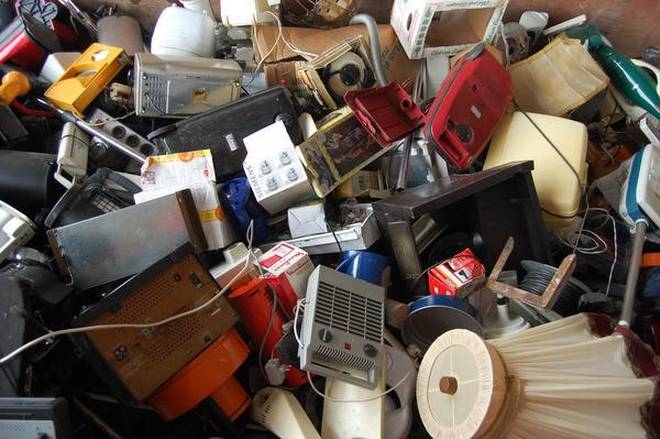


294.jpeg)




